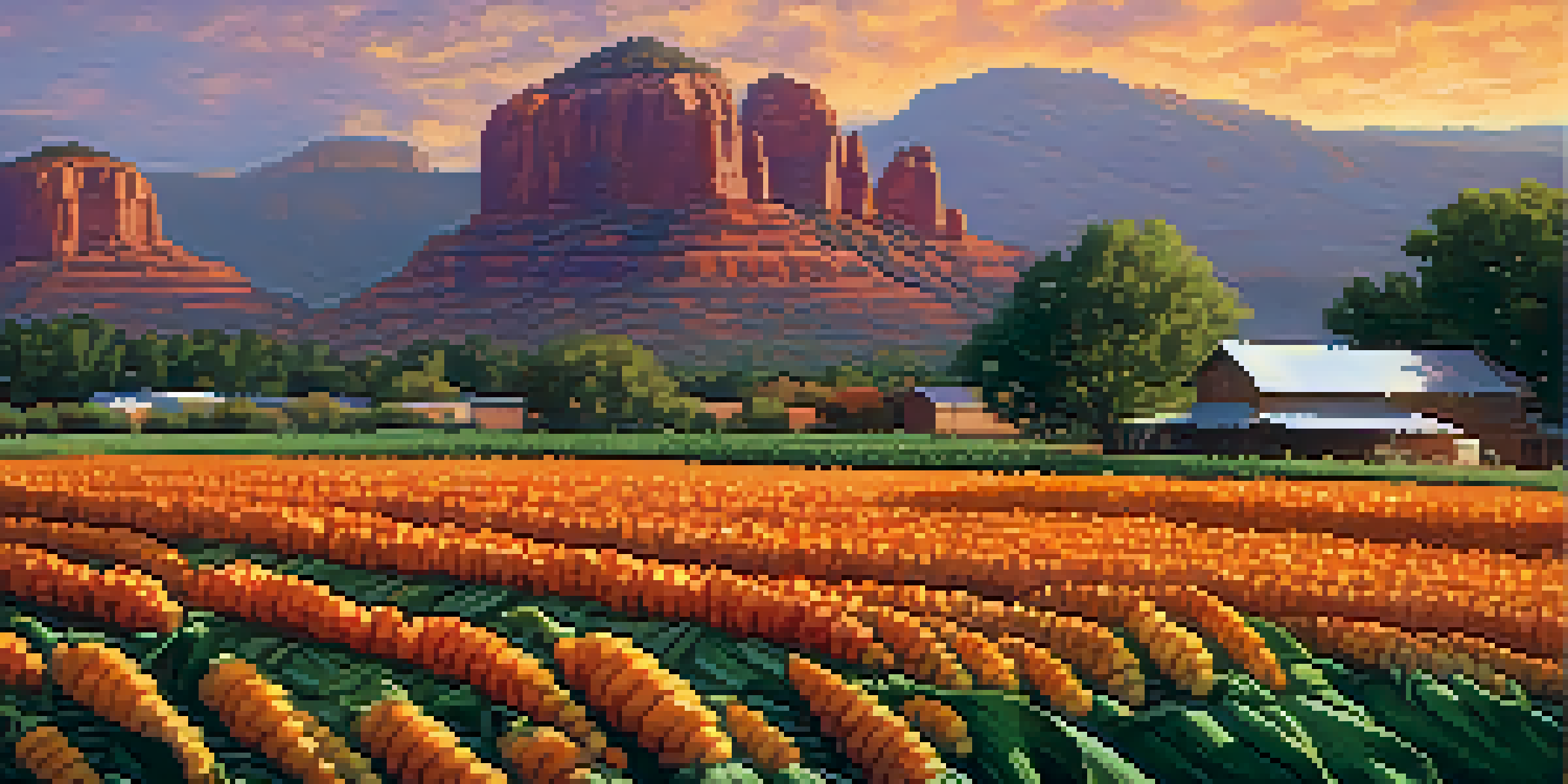The Development of Sedona's Agriculture: A Historical View

The Roots of Sedona's Agriculture: Early Native Cultures
Sedona's agricultural history begins with the Native American tribes, including the Sinagua, who thrived in the region. They cultivated crops like corn, beans, and squash, known as the 'Three Sisters.' These crops were vital not just for sustenance but also for shaping their cultural practices and social structures.
Agriculture is our wisest pursuit, because it will in the end contribute most to real wealth, good morals, and happiness.
The Sinagua utilized the area's rich soil and water sources, employing techniques such as irrigation to maximize their harvests. This ingenuity allowed them to adapt to the arid climate, showcasing a deep understanding of their environment. Their agricultural practices were more than just farming; they were intertwined with spirituality and community life.
As European settlers arrived in the 19th century, they encountered these established agricultural practices. The wisdom of the Native cultures laid a foundation that would influence the newcomers as they began to cultivate the land, marking a pivotal moment in Sedona's agricultural journey.
The Impact of European Settlement on Local Farming
European settlers brought new farming techniques and crops to Sedona, transforming the landscape. They introduced wheat, barley, and various fruits, which diversified the agricultural output of the region. This shift not only changed what was grown but also how farming was approached.

Many settlers established small farms and ranches, utilizing the fertile land for both crops and livestock. The introduction of tools like plows and irrigation systems enhanced productivity, allowing families to sustain themselves and contribute to the local economy. Over time, these practices helped shape the community's identity.
Native Cultures Shaped Agriculture
Sedona's agricultural roots were deeply influenced by Native American tribes, particularly the Sinagua, who cultivated essential crops and integrated farming with their cultural practices.
However, the transition wasn't without challenges. The settlers faced conflicts with Native populations, resource scarcity, and harsh weather conditions. Despite these hurdles, the agricultural landscape of Sedona continued to evolve, reflecting the resilience of its farming communities.
The Rise of Commercial Agriculture in the 20th Century
As the 20th century unfolded, Sedona saw a significant shift towards commercial agriculture. Farmers began to cultivate crops on a larger scale, tapping into the growing demand for fresh produce. This shift not only provided economic opportunities but also attracted new residents and businesses to the area.
The future of agriculture is not about growing more, but about growing better.
The introduction of modern farming equipment and practices played a crucial role in this transformation. Innovations such as tractors and advanced irrigation methods led to increased efficiency and higher yields. This period marked the beginning of Sedona's reputation as a producer of quality agricultural products, especially in the context of the broader Arizona economy.
Moreover, the establishment of farmers' markets and local cooperatives helped promote Sedona's agricultural bounty. These platforms allowed farmers to connect directly with consumers, creating a sense of community and appreciation for locally grown food.
Environmental Challenges and Sustainable Practices
With the growth of agriculture in Sedona came environmental challenges that farmers had to address. Issues such as soil erosion, water scarcity, and the impact of climate change became increasingly prominent. Farmers recognized the need to adapt their practices to ensure the sustainability of their operations.
In response, many local farmers turned to sustainable agricultural practices. Techniques such as crop rotation, organic farming, and water conservation measures were implemented to preserve the land's health. These practices not only benefited the environment but also appealed to a growing consumer base that values sustainability.
European Settlers Transformed Farming
The arrival of European settlers introduced new crops and farming techniques, significantly diversifying Sedona's agricultural practices and landscape.
As a result, Sedona has become a model for balancing agricultural productivity with environmental stewardship. This commitment to sustainability reflects a broader trend in agriculture, where farmers are not just producers but also caretakers of the land.
The Influence of Tourism on Sedona's Agriculture
Sedona's stunning natural beauty has made it a popular tourist destination, and this influx of visitors has influenced local agriculture. Many farmers have started to cater to the tourism industry by offering agritourism experiences, such as farm tours and U-pick events. This connection to tourism adds another layer to Sedona's agricultural landscape.
By engaging with tourists, farmers can showcase their products while educating visitors about local farming practices. This interaction fosters a greater appreciation for agriculture and promotes the consumption of locally sourced food. As tourists seek authentic experiences, Sedona's agricultural offerings become a unique attraction.
However, this relationship also poses challenges, as the needs of tourists can sometimes conflict with agricultural practices. Balancing the demands of tourism with sustainable farming requires creativity and collaboration among local stakeholders.
Community Support and the Local Food Movement
The local food movement has gained momentum in Sedona, bringing community members together to support local agriculture. Residents increasingly prioritize eating locally sourced produce, which in turn boosts the local economy and strengthens community ties. This shift reflects a growing awareness of the benefits of supporting local farmers.
Initiatives such as community-supported agriculture (CSA) programs have emerged, allowing consumers to directly invest in local farms. These programs often provide subscribers with a regular supply of fresh, seasonal produce while offering farmers a stable income. This model not only connects people to their food but also fosters a sense of community ownership.
Sustainable Practices for Future Farming
As environmental challenges arise, Sedona's farmers are embracing sustainable practices to balance productivity with ecological stewardship.
Furthermore, local events like farm-to-table dinners and food festivals highlight the region's agricultural bounty. Such gatherings celebrate the hard work of local farmers and encourage residents to engage with their food sources, creating a vibrant community around agriculture.
The Future of Agriculture in Sedona: Innovation and Tradition
Looking ahead, the future of agriculture in Sedona appears bright, blending innovation with tradition. Farmers are increasingly adopting technology, such as precision agriculture and vertical farming, to enhance productivity and sustainability. This integration of modern practices with time-honored techniques reflects a commitment to progress while honoring the past.
The ongoing challenge of climate change will likely shape the strategies farmers employ. Emphasizing resilience and adaptability, Sedona's agricultural community is poised to experiment with new crops and methods to respond to changing environmental conditions. This proactive approach will be essential in ensuring the long-term viability of local farming.

As Sedona continues to grow as a destination and community, the role of agriculture will remain pivotal. By marrying innovation with the rich agricultural heritage of the region, Sedona can cultivate a sustainable future that benefits both farmers and the wider community.